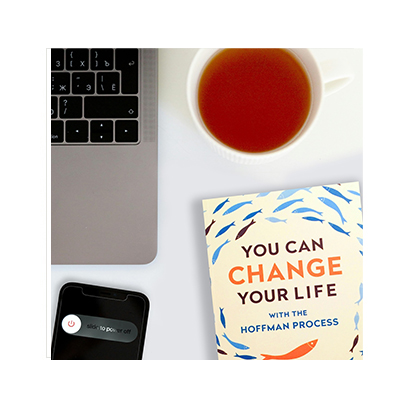A Journey to Love & Freedom
 Many people will have heard of the Hoffman Process and wondered why it attracts such unreserved praise from people such as author Joan Borysenko, and the expert on addictive behaviour, John Bradshaw, so Michelle Pilley decided to embark on the course and find out more.
Many people will have heard of the Hoffman Process and wondered why it attracts such unreserved praise from people such as author Joan Borysenko, and the expert on addictive behaviour, John Bradshaw, so Michelle Pilley decided to embark on the course and find out more.
I am probably not alone in feeling a little wary of intense psychotherapeutic courses involving deprivation and confrontation. The descriptions of the Hoffman Process made it sound very different from these courses, but committing yourself to an 8-day intensive process is always a little nerve-racking.
My nervousness was not eased when I received the Pre-Course Work. This is an extensive survey of our relationships with our parents and necessitates the identification of numerous negative traits that we have adopted from them. These can be characteristics that we have rebelled against and are therefore acting out as diametrically opposed behaviour in our lives.
At first glance I thought that I would quickly be able to complete the questions, but as I got into it, I found that I needed time for reflection and consultation with friends and family to get their mirrors of the patterns that I acted out in my life.
Whilst identifying the similarities was straightforward, looking at where a trait is actually a rebellion is more subtle. I found myself needing the 8-12 hours that the Institute had suggested and at the end of that time recognised that I had entered a slightly rebellious mode and had not completed the information as thoroughly as had been requested. Just this process in itself set off much thought and recollection regarding my own experiences and patterns and so I was looking forward to beginning the course and tackling these knotty characteristics that can constrain us so effectively.
Arriving at Florence House, the UK venue for the Hoffman Process, late on the evening before the course was due to start, I immediately felt a sense of reassurance, safety and excitement. Michelle Stevenson, who owned Florence House (which is named after her mother), had the vision to establish the centre six years ago, after completing her own Process. At the time the UK Institute was looking for a good venue for the course and Michelle has certainly created just that with extraordinary love and care.
On my course there were several people whose partners had completed the Process one or two months earlier. They felt that the person who arrived home at the end of the course was quite different in many ways from the person who had left the week before. In some cases this can create a pressure for change on the partner who has not ‘done the Process’. But, even if there is initial difficulty dealing with this changed person in front of you, the fact that they have managed to transform some of their most basic ‘horrendousness’ and dropped well-worn masks is one hell of an incentive for their partner to do the course.
As a result, many partners who have completed the Process (couples cannot attend the same course together) seem to enjoy far more loving relationships. There is no miracle cure but people have changed, and if they feel old patterns start to emerge, they are well equipped with the Hoffman bag of magic tricks, known as ‘The Tools’, to be able to clear the pattern before it can cause any harm.
One person in my group whose partner had completed the course waited several years before deciding to do the course herself. Her partner had not put any pressure on her to do the Process, but the changes in him were so positive and, significantly, had not disappeared when the after-course glow or euphoria faded. Such enduring testaments seemed to be the common experience of many people on my course whose friends and colleagues had encouraged them to go through this experience.
One woman spoke of a boss of her company, a very unhappy and difficult individual who made her employees’ lives very difficult. The change in her boss was immediate and long-lasting. She is so transformed in her working relationships that many of her colleagues have felt inspired to undertake the Process.
Telling each other these encouraging testimonial stories helped build up our confidence on the first day as we were introduced to our teachers and had our introductory interviews with them. The course was full – 24 participants, three teachers and three trainee assistants. My course was led by Cynthia Merchant from the US who has been a Hoffman teacher for over 14 years. She was supported by Lisa Wenger, a Swiss-Italian who is one of the founders of the Italian Institute and now teaches throughout Europe, and Karen Jepsen, an Australian now living in the UK and working for the UK Institute. They all have experienced and grounded backgrounds in psychotherapeutic and personal development work and from the beginning inspired us with a great sense of safety and confidence.
The Process is the vision of Robert Hoffman, a gifted US ‘sensitive’ born in 1921, who spiritually counselled people whilst earning his living as a tailor. Hoffman is described by the Institute as a ‘gifted and generous man who dedicated his life to awakening the awesome power of love that dwells within all of us. He believed that unconditional love was the birthright of every human being.’
The initial insight came to him in 1967 and for the next five years he collaborated with psychotherapists and psychiatrists to help individuals on a 1:1 basis. In 1972 he, and noted psychiatrist Claudio Naranjo MD, began presenting Hoffman’s method as a 13-week course in a group setting.
In 1985 Hoffman reformatted his programme into an 8-day residential intensive, renamed it the Hoffman Quadrinity Process and then initiated an eight-year period of inspired development and refinement. Robert Hoffman retired from teaching the Process in 1991 but remained active in his work until his death in 1997. One of his most well-known maxims and a sentiment that was close to his heart is that ‘No one who has done the Hoffman Quadrinity Process could start a war’.
Having gone through the Process, I understand this maxim very well – in ‘putting our consciousness on our unconsciousness’, we were encouraged to seek liberation from the patterns that have held us and the past generations of our own families locked in repetitive cycles of pain, violence and suffering. In my group, several people with children had come with the intent of clearing themselves so that they could avoid passing on their limiting patterns and cycles to their children.

Each day breakfast started at 7:30am and during the meal we were given the instructions for the work of the day. The day typically did not finish until after 10pm at the earliest, and throughout the day personal time involved writing tasks.
The group was very much a team, so no one could be left behind at any stage. The momentum is very important, as is the connection between the members of the group. This connection created a supportive energy field that enabled everyone to get through. At no point did comparison or failure come into it.
People didn’t get snared by their egos.We were just encouraged to be conscious of the block, defeat the negative pattern that lay behind the block and move on. If one person hit a problem the teacher was immediately there working with the individual and, if appropriate, they called on the group to add their love and support to help the person move onwards. There was an extraordinary sense of the group moving at great speed while conversely having seemingly limitless time to stop whenever an individual needed to slow down.
I had been attracted to the Process because it was clear from the promotional material that the course worked with both the psyche and the spirit. But as I understood more about the philosophy, it became clear that the Quadrinity itself is actually the integration of the Four Aspects of Self . The Quadrinity is defined as a framework – a model for understanding ourselves and our behaviour that includes all four interrelated aspects forming a complex interactive system.
From the very beginning of the course, through visualisation, we accessed the different aspects of ourselves and spoke to our emotional and our intellectual selves about our destructive patterns. The relationship between these two is known in the Process as the Duality. The heated conversation that my intellectual self and my emotional self had as they explained things from their point of view was extremely insightful for me to hear. At times it was very funny to witness these two aspects of myself, trying to move in opposite directions, paying no attention to each other. The processes and rituals which we were led along to heal this dysfunctional relationship were powerful and I have found them to be long-lasting. It would have been worth attending the course just for the gift of this new inner relationship, but at so many places along the Pathway of the Process the journeyer uncovers treasure that seems to hold its value long after the journey has been completed.
Seeing the different, separate aspects of the self mirrored in other members of our group allowed us to realise how often we are reacting to people through what the teachers described as knee-jerk experiences. Either the knee-jerk can be caused by the parental filter that we place over our perception, i.e. seeing our parents in everyone we meet; or alternatively we can see a pattern in someone else and decide that the pattern is who they are, instead of looking for the soul of the person in front of us. The Process helped us to learn how to strip away those transferences and judgements and find a truly more loving place with each other.
‘Being more loving with each other’ are words that we all see on the flyers of many spiritual courses and in many personal development books. Easy to say but much harder to make real. But I can say with some confidence that, for the 24 of us on the course, we know how it feels to be loving – and that is no small thing.
Through encountering the patterns that our parents have passed to us and releasing the anger we feel about these constricting traits, we reach a place where we are able to step into a closer understanding of our parents. After framing our case against them, we prepare the case for the defence and, as part of this, we speak from our pre-pubescent 12 year-old self to the pre-pubescent self of each parent in turn. When briefed about this part of the work people felt doubtful that it could work. Some people knew very little detail about their parents’ childhoods and others just thought they would not be able to do it.
The course leader, Cynthia, has written a fascinating doctorate thesis comparing the Process to Joseph Campbell’s Hero’s Journey, and in this she mentions how important this part of the Process was to Bob Hoffman himself: ‘The defence is the turning point in the Process where participants are asked to look beyond their own pain and probe deeply into the pain and suffering of their parents’ early lives.’
We were all profoundly affected by this experience, and many people were amazed by what they had discovered about their parents’ childhoods. Cynthia mentions that psychologist Claude Naranjo was particularly impressed by the participants’ ability to uncover facts about their parents that they had not previously known (which had turned out to be true when the details were checked). For myself and the other members of the group, the chance to experience what our parents felt created a profound change in us. The memory of this is not likely to fade for any of us.
The experience allowed us to step into the place of forgiveness for our parents and be able to acknowledge the truth of the statement that: ‘Everyone is guilty, but no one is to blame.’ It is an extraordinary thing to witness people moving from the place of hatred to forgiveness and compassion for parents who have been abusers and oppressors. The wider implications of this work give it enormous spiritual significance and it is this spiritual quality that led Joan Borysenko to recommend it so strongly: ‘A crucial aspect of the Hoffman Process is the spiritual context in which the anger, forgiveness, compassion and reparenting work is done.
As the teachers prepared us to leave the wonderful connection and safety of this fantastic group of people we were reminded that we were not special to have completed this course – just very fortunate. It is my wish that as many other people as possible might also be so fortunate.





 Sign up to receive monthly newsletters from Hoffman
Sign up to receive monthly newsletters from Hoffman